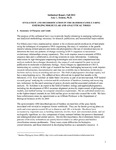- DSpace Home
- →
- Channel Islands
- →
- Academic Affairs
- →
- Sabbatical Reports
- →
- 2011
JavaScript is disabled for your browser. Some features of this site may not work without it.
| dc.contributor.author | Denton, Amy | en |
| dc.date.accessioned | 2011-05-31T15:41:11Z | en |
| dc.date.available | 2011-05-31T15:41:11Z | en |
| dc.date.issued | 2011-05-31 | en |
| dc.identifier.uri | http://hdl.handle.net/10139/4025 | en |
| dc.description.abstract | Bamboos (Poaceae: Bambusoideae) include between 1,200 and 1,400 species, and are found in tropical to temperate areas worldwide. The evolutionary history of bamboos has been difficult to infer with comparative sequence analysis: problems include rapid radiation events, relatively slow rates of sequence evolution, limited variation in trialed nuclear loci, and lack of convincing resolution at key nodes in gene topologies. Although some researchers advocate a phylogenomic approach for problematic taxa like bamboos, a reasonable (and inexpensive) alternative might be to target loci that are strong phylogenetic performers. Three such introns were recently identified by the authors using multilocus comparisons with a corroborated chloroplast topology of 14 bamboo species. In the present study, we resample the taxon set of the Bamboo Phylogeny Group (BPG) and estimate a chloroplast phylogeny using sequence data from the atpF, trnG, and petB introns. Although our combined data set is only one third the size of the BPG alignment, it recovers all but two of the supported branches in the BPG estimation. Our analysis provides the first independent corroboration of BPG’s chloroplast phylogeny for bamboos, and suggests that these three introns could be more widely used for phylogenetic inference in the grasses. | en |
| dc.language.iso | en_US | en |
| dc.title | Sabbatical Report, Fall 2010. Evolution and Diversification in the Bamboo Family Using Emerging and Analytical Tools. | en |
| dc.type | Other | en |
Files in this item
The following license files are associated with this item:
This item appears in the following Collection(s)
-
2011 [5]

